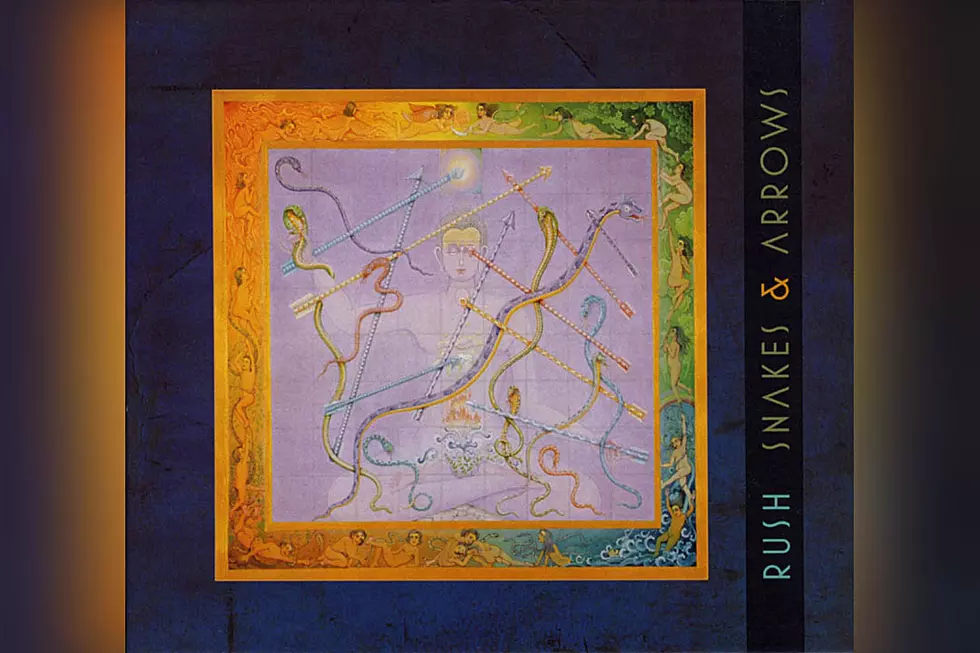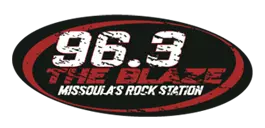
How Rush Connected the Dots With ‘Snakes and Arrows’
When Rush released their 18th album, Snakes & Arrows, on May 1, 2007, it heralded a most glorious era of the Canadian trio’s already-glittering career. It also seemed to herald the beginning of their end – although it did so in impressive style.
If the follow-up to 2002’s comeback Vapor Trails appeared to connect a row of dots from the band’s history, that was the desired effect, mainly as a result of co-producer Nick Raskulinecz’s input. He’d applied for the job as soon as he heard the record was in the works, and, in an informal meeting with the band, he sold the trio a concept of performing with as much virtuosity as possible, while revisiting an exploration of complex rhythms and melodies. Everything, in short, that Rush loved to do.
Guitarist Alex Lifeson made a conscious decision to focus on acoustic guitar for his songwriting after a discussion with Pink Floyd’s David Gilmour (who received a credit for his advice). “I was playing a lot of acoustic guitars before we started the record," Lifeson told Guitar Player. "I had a meeting with David, and he was a very engaging, charming guy. We talked a lot about the power of the acoustic in terms of writing. It doesn’t lie. It tells you straight up whether an idea has merit.”
On hearing the demo tracks laid down by Lifeson and singer and bassist Geddy Lee, drummer Neil Peart used the world “spiritual.” “When I first listen to a rough sketch of guitar, bass, vocal, and drum machine, I am hearing it as the lyricist, and I am also listening as the drummer," he wrote in an essay. "In a larger sense, though, I’m really listening as a fan – someone who wants to love that song. Even on first listen, I felt that way about ‘Bravest Face’ and ‘The Way the Wind Blows,’ and I was especially excited by how different they were from anything we had done before – fresh and vital, yet rooted in some deeper musical streams.”
Speaking of how the new music compared with their earlier work, Peart noted, “While the arrangements remained intricate and dynamic, the elements were often simple and direct – basic hard rock and blues forms.”
Spirituality became one theme of the album’s lyrics, along with the concept of expressing the individual’s relationship with the world within the terms of a “lover’s quarrel.” Peart even offered some words he’d written 15 years previously, on the subject of “fortunes and fates.” “It must have been the right time, because, to my delight, Alex and Geddy responded to the challenge,” he said, adding of lyrics, “Many are sent; few are chosen.”
In November 2006, Rush decamped to Allaire Studios in New York for what was supposed to be a two-week stint. But they discovered the location suited them well, so they abandoned plans to do another three weeks in Toronto, and instead stayed at Allaire for six weeks total. Under the guidance of Raskulinecz – who’d been nicknamed “Booujze” as a result of his frequent use of vocal sound effects to make a musical point – they worked on a track-by-track basis, aiming to make each recording a proper performance. “Even if we were playing alone to a recorded guide track, it was still us, and we ‘meshed’ automatically,” Peart reported.
Along with the usual brand of ambitious compositions came another new move for the band: three instrumental tracks, ‘The Main Monkey Business,’ ‘Hope’ and ‘Malignant Narcissism’ made the final cut. Peart described ‘Hope’ as Lifeson’s “secular prayer” and revealed he’d recorded ‘Malignant Narcissism’ on a small, four-piece drum kit rather than his usual giant setup “just for fun.”
The title Snakes & Arrows, which the band felt summed up the lyrical themes, was a merging of the kids’ board game Snakes and Ladders with the “slings and arrows” line from Shakespeare’s Hamlet. Peart discovered that the term did actually exist, and had been used in a Buddhist karma-based educational game for 2,000 years. An illustration of Leela, the main character in the game, became the cover artwork co-created between Peart and Hugh Syme.
On March 12, 2007, Rush released “Far Cry,” the debut single from Snakes & Arrows. To emphasize the point they were trying to make, the accompanying video nodded to the band’s earlier eras, while embracing modern, moody stop-motion production. The track did seem to encompass everything the band had tried to achieve with the project, and it became a live staple, being performed on every tour since its release (complete with a victory salute shared between Lee and Peart after the last note is struck).
“I remember with ‘Far Cry,’ I was working on lyrics and brought them in at the end of the day," Peart later said. "Geddy looked at them and went, ‘Wait a minute!’ It went with what he had been stitching together that day. So that song was inter-created. It grew organically. Most of our songs have grown that way. Writing songs is really an exchange of ideas. And the synchronicity between us is remarkable sometimes.”
Listen to Rush's 'The Main Monkey Business'
“Far Cry” (the staccato hook, the howling guitar break that’s more of a sound than a solo) reached No. 22 on the Billboard Hot Mainstream Rock chart. It’s successor, “Spindrift” (which featured a heavy riff that flirts round the edge of doom, with its feet firmly in the ‘80s) didn’t chart, while later releases “The Larger Bowl (A Pantoum)” (close harmony vocal riff and leading acoustic guitar phrase) and “Workin’ Them Angels” (anthemic rocker featuring a few trademark time changes) reached No. 16 and 30, respectively. The album fared better, reaching No. 3 on the Billboard 200, and remained in play for 14 weeks. Their record label chose Snakes & Arrows to be the debut title of the new Music Video Interactive format.
Raskulinecz compared Snakes & Arrows to the band’s ‘70s output. “I feel they’ve written some of the best material they’ve written, and they’re playing at the top of their abilities," he said to Brightcove . "We’ve made a performance record. And I think it’s got a different sound – it sounds like all the elements of classic Rush, but it doesn’t sound like a classic rock record. It has all the energy and sonics of a relevant, modern-day rock record.”
It worked for the majority of Rush fans, and it most certainly worked for the trio. (Giving it three stars out of five, Rolling Stone dryly observed: “If you’re a fan, add two stars; if not, subtract two.”)
In 2014, Lee told TeamRock, “I think I’d place Snakes & Arrows among our top three albums. We found that space we’ve been wanting to get to in terms of keeping the balance of influences. There are so many ways we can go, and because we’re over-ambitious when putting our songs together, it’s very easy to bloat in one direction or lose yourself in the excitement of a new sound.
“I think it began with Vapor Trails, and I think Feedback helped because it reminded us of our roots, and fundamental things about rock songs that may have got lost in the technocratic attitude that we sometimes have.”
“When we finished that record, we really felt that its closest cousin was Moving Pictures," Lifeson noted. "To us, there was something about it that had the same feel that Moving Pictures had. We were very happy with Snakes & Arrows. And that level of confidence was something we took into Clockwork Angels.”
By the time Clockwork Angels – Rush’s final album – came along in 2012, the band had experienced the greatest height of its fame. Snakes & Arrows was the opening scene in a story that included an appearance in the 2009 film I Love You, Man, the release of the acclaimed 2010 documentary Beyond The Lighted Stage, their 2013 induction into the Rock and Roll Hall of Fame and receipt of a string of musical and humanitarian awards.


